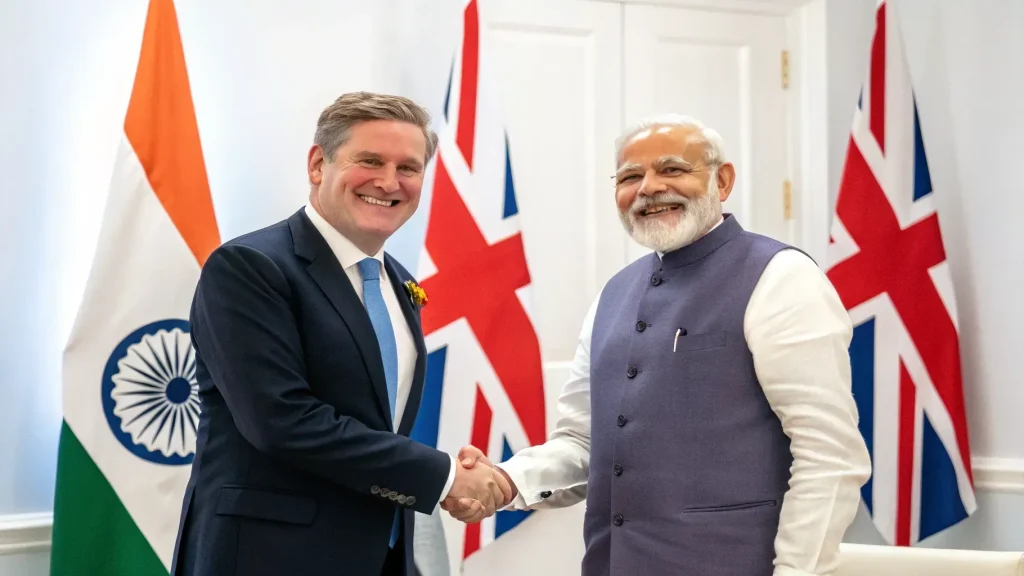The recent U.K. India trade agreement marks a significant milestone in bilateral relations, poised to generate an impressive annual increase of over $34 billion in trade by 2040. This historic free trade agreement (FTA) aims to enhance economic cooperation by dramatically reducing tariffs on key imports and exports such as textiles, automobiles, and alcohol. Leaders from both nations, including Indian Prime Minister Narendra Modi and U.K. Prime Minister Keir Starmer, hailed the deal as a pathway to sustainable economic growth, positioning their countries strategically in a competitive global market. With a commitment to bilateral trade increase and better accessibility for Indian products, this agreement stands to benefit consumers and businesses alike. As the world’s fifth and sixth largest economies strengthen their ties, the potential for mutual prosperity with the U.K. India FTA remains a promising prospect on the international trade landscape.
The newly signed trade pact between the United Kingdom and India is expected to revolutionize their economic partnership, with long-term implications for trade volumes and commercial collaboration. This free trade arrangement is seen as a crucial step in fostering a more integrated market, where tariff reductions will play a vital role in facilitating smoother exchanges of goods and services. Economists predict that the agreement could drive a substantial surge in bilateral trading activity, particularly in lucrative sectors such as automotive and textiles. Furthermore, through this landmark accord, both nations illustrate their commitment to advancing economic growth while navigating the complexities of global trade dynamics. Emphasizing mutual growth, this agreement not only opens new avenues for trade but also underscores the growing interdependence between the U.K. and India’s economies.
Impact of the U.K.-India Trade Agreement on Bilateral Trade
The recently signed U.K.-India free trade agreement (FTA) is expected to create a ripple effect in bilateral trade, projecting an annual increase of more than $34 billion. This monumental deal signifies a shift in economic dynamics between two major economies, fostering opportunities for enhanced trade relations. With both countries standing as the fifth and sixth largest economies globally, the FTA aims to solidify and elevate their trading stature on the world stage.
Furthermore, the agreement is anticipated to contribute significantly to the increase in trade volumes by eliminating tariffs on critical products, thereby lowering costs for consumers and businesses alike. As both nations gear up for a future of closer economic ties, the impact of this deal could lead to trade levels approaching £25.5 billion annually by 2040, a promising forecast that highlights the commitment to mutual growth.
Frequently Asked Questions
What is the significance of the U.K. India trade agreement for bilateral trade?
The U.K. India trade agreement is significant as it is expected to increase bilateral trade by over £25.5 billion annually by 2040, following a historic free trade agreement (FTA) that reduces tariffs on various goods and enhances market access.
How does the U.K. India FTA affect tariffs on goods?
Under the U.K. India FTA, tariffs on 92% of goods exported from the U.K. to India will be eliminated or reduced, while 99% of Indian goods to the U.K. will face no tariffs, promoting trade growth between the two nations.
What sectors will benefit from the U.K. India trade agreement?
The sectors benefiting from the U.K. India trade agreement include textiles, gems, jewelry, and agriculture, with Indian products gaining improved access to the U.K. market due to reduced tariff barriers.
In what ways is the U.K. India FTA expected to enhance economic growth?
The U.K. India FTA is expected to enhance economic growth by boosting exports, improving employment opportunities, and lowering prices for consumers, benefiting both nations’ economies significantly.
What are the potential challenges in ratifying the U.K. India trade agreement?
The U.K. India trade agreement requires ratification from the parliaments of both countries, which could present challenges and may take several months, potentially delaying the benefits of the FTA.
How does the U.K. India trade agreement impact the U.K. scotch and gin industry?
The U.K. India trade agreement will substantially reduce tariffs on U.K. scotch and gin, from 150% to 75%, and further to 40% over a decade, promoting a more favorable trading environment for these products in India.
What role does the U.K. India trade agreement play in global trade dynamics?
The U.K. India trade agreement positions both countries favorably in global trade dynamics, showcasing India’s readiness to engage with developed economies and strengthening its trade partnerships overall.
What are the expected long-term benefits of the U.K. India FTA?
The long-term benefits of the U.K. India FTA include increased bilateral trade, higher economic output for the U.K., enhanced living standards, and improved access for Indian products in the U.K. market.
How does the U.K. India trade agreement address the issue of social security for Indian workers?
The U.K. India trade agreement exempts Indian temporary workers and their employers from social security contributions for three years, facilitating easier employment conditions in the U.K.
| Key Point | Details |
|---|---|
| Historic Trade Agreement | U.K. and India have signed a free trade agreement (FTA) projected to increase trade by over $34 billion annually. |
| Tariff Reductions | The FTA reduces tariffs on several goods, enabling 92% of U.K. goods to India to be tariff-free, and 99% of Indian goods to the U.K. will be exempt from tariffs. |
| Long-Term Economic Impact | By 2040, bilateral trade is expected to increase by £25.5 billion annually; enhancing wages and reducing prices for consumers. |
| Social Security Exemptions | Temporary Indian workers in the U.K. and their employers will be exempt from social security contributions for three years. |
| Industry Benefits | Sectors such as textiles, gems and jewelry, and automobiles are set to benefit significantly from improved market access. |
| Significance for India | The deal solidifies India’s position in international trade negotiations and improves its trade surplus. |
| Expected Economic Growth | The deal is anticipated to boost U.K. economic output by an additional £4.8 billion annually. |
| Future Trade Relations | This agreement serves as a springboard for India’s trade discussions with other developed countries. |
Summary
The U.K.-India trade agreement marks a significant milestone in the economic partnership between the two nations, expected to generate over $34 billion in annual trade. This historic deal not only reduces tariffs on a wide range of goods but also provides substantial boosts to various sectors within both countries. By enhancing trade relations and improving market access, the agreement positions India as a pivotal player on the global trade stage while also driving economic growth in the U.K. As both countries move towards ratification, the long-term impact of this trade pact promises an increase in employment, improved living standards, and a competitive edge in international markets.


